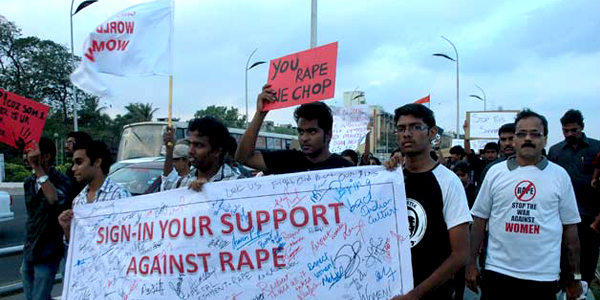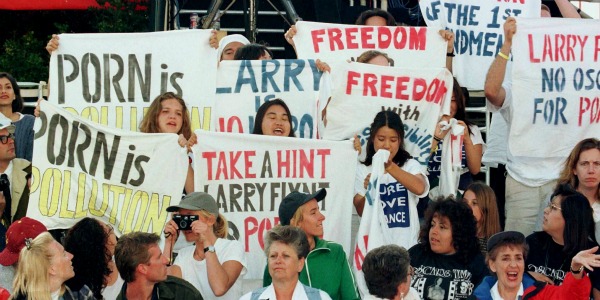It was a key match in the World Cup of Ideas. The teams vied furiously for the ball. The all-star feminist team tried repeatedly to kick it through the goalposts marked Widespread Social Problems, while the opposing team, staffed by the mainstream media and mainstream dudes, was intent on getting it into the usual net called Isolated Event. To keep the ball out of his net, the mainstream’s goalie shouted “mental illness” again and again. That “ball,” of course, was the meaning of the massacre of students in Isla Vista, California, by one of their peers.
All weekend the struggle to define his acts raged. Voices in the mainstream insisted he was mentally ill, as though that settled it, as though the world were divided into two countries called Sane and Crazy that share neither border crossings nor a culture. Mental illness is, however, more often a matter of degree, not kind, and a great many people who suffer it are gentle and compassionate. And by many measures, including injustice, insatiable greed, and ecological destruction, madness, like meanness, is central to our society, not simply at its edges.
In a fascinating op-ed piece last year, T.M. Luhrmann noted that when schizophrenics hear voices in India, they’re more likely to be told to clean the house, while Americans are more likely to be told to become violent. Culture matters. Or as my friend, the criminal-defense investigator who knows insanity and violence intimately, put it, “When one begins to lose touch with reality, the ill brain latches obsessively and delusionally onto whatever it’s immersed in — the surrounding culture’s illness.”
The murderer at Isla Vista was also repeatedly called “aberrant,” as if to emphasize that he was nothing like the rest of us. But other versions of such violence are all around us, most notably in the pandemic of hate toward and violence against women.
In the end, this struggle over the meaning of one man’s killing spree may prove to be a watershed moment in the history of feminism, which always has been and still is in a struggle to name and define, to speak and be heard. “The battle of the story” the Center for Story-Based Strategy calls it, because you win or lose your struggle in large part through the language and narrative you use.
As media critic Jennifer Pozner put it in 2010 about another massacre by a woman-hating man,
“I am sick to death that I have to keep writing some version of this same article or blog post on loop. But I have to, because in all of these cases, gender-based violence lies at the heart of these crimes — and leaving this motivating factor uninvestigated not only deprives the public of the full, accurate picture of the events at hand, but leaves us without the analysis and context needed to understand the violence, recognize warning signs, and take steps to prevent similar massacres in the future.”
The Isla Vista murderer took out men as well as women, but blowing away members of a sorority seems to have been the goal of his rampage. He evidently interpreted his lack of sexual access to women as offensive behavior by women who, he imagined in a sad mix of entitlement and self-pity, owed him fulfillment.
#YesAllWomen
Richard Martinez, the father of one of the young victims, spoke powerfully on national TV about gun control and the spinelessness of the politicians who have caved to the gun lobby, as well as about the broader causes of such devastation. A public defender in Santa Barbara County, he has for decades dealt with violence against women, gun users, and mental illness, as does everyone in his field. He and Christopher Michaels-Martinez’s mother, a deputy district attorney, knew the territory intimately before they lost their only child. The bloodbath was indeed about guns and toxic versions of masculinity and entitlement, and also about misery,cliché, and action-movie solutions to emotional problems. It was, above all, about the hatred of women.
 According to one account of the feminist conversation that followed, a young woman with the online name Kaye (who has since been harassed or intimidated into withdrawing from the public conversation) decided to start tweeting with the hashtag #YesAllWomen at some point that Saturday after the massacre. By Sunday night, half a million #yesallwomen tweets had appeared around the world, as though a dam had burst. And perhaps it had. The phrase described the hells and terrors women face and specifically critiqued astock male response when women talked about their oppression: “Not all men.”
According to one account of the feminist conversation that followed, a young woman with the online name Kaye (who has since been harassed or intimidated into withdrawing from the public conversation) decided to start tweeting with the hashtag #YesAllWomen at some point that Saturday after the massacre. By Sunday night, half a million #yesallwomen tweets had appeared around the world, as though a dam had burst. And perhaps it had. The phrase described the hells and terrors women face and specifically critiqued astock male response when women talked about their oppression: “Not all men.”
It’s the way some men say, “I’m not the problem” or that they shifted the conversation from actual corpses and victims as well as perpetrators to protecting the comfort level of bystander males. An exasperated woman remarked to me, “What do they want — a cookie for not hitting, raping, or threatening women?” Women are afraid of being raped and murdered all the time and sometimes that’s more important to talk about than protecting male comfort levels. Or as someone named Jenny Chiu tweeted, “Sure #NotAllMen are misogynists and rapists. That’s not the point. The point is that #YesAllWomen live in fear of the ones that are.”
Women — and men (but mostly women) — said scathing things brilliantly.
— #YesAllWomen because I can’t tweet about feminism without getting threats and perverted replies. Speaking out shouldn’t scare me.
— #YesAllWomen because I’ve seen more men angry at the hashtag rather than angry at the things happening to women.
— #YesAllWomen because if you’re too nice to them you’re “leading them on” & if you’re too rude you risk violence. Either way you’re a bitch.
It was a shining media moment, a vast conversation across all media, including millions of participants on Facebook and Twitter — which is significant sinceTwitter has been a favorite means of delivering rape and death threats to outspoken women. As Astra Taylor has pointed out in her new book, The People’s Platform, the language of free speech is used to protect hate speech, itself an attempt to deprive others of their freedom of speech, to scare them into shutting up.
Laurie Penny, one of the important feminist voices of our times, wrote,
“When news of the murders broke, when the digital world began to absorb and discuss its meaning, I had been about to email my editor to request a few days off, because the impact of some particularly horrendous rape threats had left me shaken, and I needed time to collect my thoughts. Instead of taking that time, I am writing this blog, and I am doing so in rage and in grief — not just for the victims of the Isla Vista massacre, but for what is being lost everywhere as the language and ideology of the new misogyny continues to be excused… I am sick of being told to empathize with the perpetrators of violence any time I try to talk about the victims and survivors.”
Our Words Are Our Weapons
In 1963, Betty Friedan published a landmark book, The Feminine Mystique, in which she wrote, “The problem that has no name — which is simply the fact that American women are kept from growing to their full human capacities — is taking a far greater toll on the physical and mental health of our country than any known disease.” In the years that followed, that problem gained several names: male chauvinism, then sexism, misogyny, inequality, and oppression. The cure was to be “women’s liberation,” or “women’s lib,” or “feminism.” These words, which might seem worn out from use now, were fresh then.
Since Friedan’s manifesto, feminism has proceeded in part by naming things. The term “sexual harassment,” for example, was coined in the 1970s, first used in the legal system in the 1980s, given legal status by the Supreme Court in 1986, and given widespread coverage in the upheaval after Anita Hill’s testimony against her former boss, Clarence Thomas, in the 1991 Senate hearings on his Supreme Court nomination. The all-male interrogation team patronized and bullied Hill, while many men in the Senate and elsewhere failed to grasp why it mattered if your boss said lecherous things and demanded sexual services. Or they just denied that such things happen.
Many women were outraged. It was, like the post-Isla Vista weekend, a watershed moment in which the conversation changed, in which those who got it pushed hard on those who didn’t, opening some minds and updating some ideas. The bumper sticker “I Believe You Anita” was widespread for a while. Sexual harassment is now considerably less common in workplaces and schools, and its victims have far more recourse, thanks in part to Hill’s brave testimony and the earthquake that followed.
So many of the words with which a woman’s right to exist is adjudicated are of recent coinage: “domestic violence,” for example, replaced “wife-beating” as the law began to take a (mild) interest in the subject. A woman is still beaten every nine seconds in this country, but thanks to the heroic feminist campaigns of the 1970s and 1980s, she now has access to legal remedies that occasionally work, occasionally protect her, and — even more occasionally — send her abuser to jail. In 1990, the Journal of the American Medical Association reported, “Studies of the Surgeon General’s office reveal that domestic violence is the leading cause of injury to women between the ages of 15 and 44, more common than automobile accidents, muggings, and cancer deaths combined.”
I go to check this fact and arrive at an Indiana Coalition Against Domestic Violencewebsite that warns viewers their browsing history might be monitored at home and offers a domestic-violence hotline number. The site is informing women that their abusers may punish them for seeking information or naming their situation. It’s like that out there.
One of the more shocking things I read recently was an essay in the Nation about the infamous slaying of Catherine “Kitty” Genovese in a neighborhood in Queens, New York, in 1964. The author, Peter Baker, reminds us that some of the neighbors who witnessed parts of her rape and murder from their windows likely mistook the savage assault by a stranger for a man exercising his rights over “his” woman. “Surely it matters that, at the time, violence inflicted by a man on his wife or romantic partner was widely considered a private affair. Surely it matters that, in the eyes of the law as it stood in 1964, it was impossible for a man to rape his wife.”
Terms like acquaintance rape, date rape, and marital rape had yet to be invented.
Twenty-First Century Words
I apparently had something to do with the birth of the word “mansplaining,” though I didn’t coin it myself. My 2008 essay “Men Explain Things to Me” (now the title piece in my new book about gender and power) is often credited with inspiring the pseudonymous person who did coin it on a blog shortly thereafter. From there, it began to spread.
For a long time, I was squeamish about the term, because it seemed to imply that men in general were flawed rather than that particular specimens were prone to explain things they didn’t understand to women who already did. Until this spring, that is, when a young PhD candidate at the University of California, Berkeley, told me that the word allowed women to identify another “problem with no name,” something that often happened but was hard to talk about until the term arose.
Language is power. When you turn “torture” into “enhanced interrogation,” or murdered children into “collateral damage,” you break the power of language to convey meaning, to make us see, feel, and care. But it works both ways. You can use the power of words to bury meaning or to excavate it. If you lack words for a phenomenon, an emotion, a situation, you can’t talk about it, which means that you can’t come together to address it, let alone change it. Vernacular phrases — Catch-22, monkeywrenching, cyberbullying, the 99% and the 1% — have helped us to describe b
ut also to reshape our world. This may be particularly true of feminism, a movement focused on giving voice to the voiceless and power to the powerless.
One of the compelling new phrases of our time is “rape culture.” The term came into widespread circulation in late 2012 when sexual assaults in New Delhi, India, and Steubenville, Ohio, became major news stories. As a particularly strongly worded definition puts it:
“Rape culture is an environment in which rape is prevalent and in which sexual violence against women is normalized and excused in the media and popular culture. Rape culture is perpetuated through the use of misogynistic language, the objectification of women’s bodies, and the glamorization of sexual violence, thereby creating a society that disregards women’s rights and safety. Rape culture affects every woman. Most women and girls limit their behavior because of the existence of rape. Most women and girls live in fear of rape. Men, in general, do not. That’s how rape functions as a powerful means by which the whole female population is held in a subordinate position to the whole male population, even though many men don’t rape, and many women are never victims of rape.”
Sometimes I’ve heard “rape culture” used to describe specifically what’s called “lad culture” — the jeering, leering subculture in which some young men are lodged. Other times it’s used to indict the mainstream, which oozes with misogyny in its entertainment, its everyday inequalities, its legal loopholes. The term helped us stop pretending that rapes are anomalies, that they have nothing to do with the culture at large or are even antithetical to its values. If they were, a fifth of all American women (and one in 71 men) wouldn’t be rape survivors; if they were, 19% of female college students wouldn’t have to cope with sexual assault; if they were, the military wouldn’t be stumbling through an epidemic of sexual violence. The term rape culture lets us begin to address the roots of the problem in the culture as a whole.
The term “sexual entitlement” was used in 2012 in reference to sexual assaults byBoston University’s hockey team, though you can find earlier uses of the phrase. I first heard it in 2013 in a BBC report on a study of rape in Asia. The study concluded that in many cases the motive for rape was the idea that a man has the right to have sex with a woman regardless of her desires. In other words, his rights trump hers, or she has none. This sense of being owed sex is everywhere. Many women are told, as was I in my youth, that something we did or said or wore or just the way we looked or the fact that we were female had excited desires we were thereby contractually obliged to satisfy. We owed them. They had a right. To us.
Male fury at not having emotional and sexual needs met is far too common, as is the idea that you can rape or punish one woman to get even for what other women have done or not done. A teenager was stabbed to death for turning down a boy’s invitation to go to the prom this spring; a 45-year-old mother of two was murdered May 14th for trying to “distance herself” from a man she was dating; the same night as the Isla Vista shootings, a California man shot at women who declined sex. After the killings in Isla Vista, the term “sexual entitlement” was suddenly everywhere, and blogs and commentary and conversations began to address it with brilliance and fury. I think that May 2014 marks the entry of the phrase into everyday speech. It will help people identify and discredit manifestations of this phenomenon. It will help change things. Words matter.
Crimes, Small and Large
The 22-year-old who, on May 23rd, murdered six of his peers and attempted to kill many more before taking his own life framed his unhappiness as due to others’ failings rather than his own and vowed to punish the young women who, he believed, had rejected him. In fact, he already had done so, repeatedly, with minor acts of violence that foreshadowed his final outburst. In his long, sad autobiographical rant, he recounts that his first week in college,
“I saw two hot blonde girls waiting at the bus stop. I was dressed in one of my nice shirts, so I looked at them and smiled. They looked at me, but they didn’t even deign to smile back. They just looked away as if I was a fool. In a rage, I made a U-turn, pulled up to their bus stop and splashed my Starbucks latte all over them. I felt a feeling [of] spiteful satisfaction as I saw it stain their jeans. How dare those girls snub me in such a fashion! How dare they insult me so! I raged to myself repeatedly. They deserved the punishment I gave them. It was such a pity that my latte wasn’t hot enough to burn them. Those girls deserved to be dumped in boiling water for the crime of not giving me the attention and adoration I so rightfully deserve!”
Domestic violence, mansplaining, rape culture, and sexual entitlement are among the linguistic tools that redefine the world many women encounter daily and open the way to begin to change it.
The nineteenth-century geologist and survey director Clarence King and twentieth-century biologists have used the term “punctuated equilibrium” to describe a pattern of change that involves slow, quiet periods of relative stasis interrupted by turbulent intervals. The history of feminism is one of punctuated equilibriums in which our conversations about the nature of the world we live in, under the pressure of unexpected events, suddenly lurch forward. It’s then that we change the story.
I think we are in such a crisis of opportunity now, as not one miserable, murderous young man but the whole construct in which we live is brought into question. On that Friday in Isla Vista, our equilibrium was disrupted, and like an earthquake releasing tension between tectonic plates, the realms of gender shifted a little. They shifted not because of the massacre, but because millions came together in a vast conversational network to share experiences, revisit meanings and definitions, and arrive at new understandings. At the memorials across California, people held up candles; in this conversation people held up ideas, words, and stories that also shone in the darkness. Maybe this change will grow, will last, will matter, and will be a lasting memorial to the victims.
Six years ago, when I sat down and wrote the essay “Men Explain Things to Me,” here’s what surprised me: though I began with a ridiculous example of being patronized by a man, I ended with rapes and murders. We tend to treat violence and the abuse of power as though they fit into airtight categories: harassment, intimidation, threat, battery, rape, murder. But I realize now that what I was saying is: it’s a slippery slope.
That’s why we need to address that slope, rather than compartmentalizing the varieties of misogyny and dealing with each separately. Doing so has meant fragmenting the picture, seeing the parts, not the whole.
A man acts on the belief that you have no right to speak and that you don’t get to define what’s going on. That could just mean cutting you off at the dinner table or the conference. It could also mean telling you to shut up, or threatening you if you open your mouth, or beating you for speaking, or killing you to silence you forever. He could be your husband, your father, your boss or editor, or the stranger at some meeting or on the train, or the guy you’ve never seen who’s mad at someone else but thinks “women” is a small enough category that you can stand in for “her.” He’s there to tell you that you have no rights.
Threats often precede acts, which is why the targets of online rape and death threats take them seriously, even though the sites that allow them and the law enforcement officials that generally ignore them apparently do not. Quite a lot of women are murdered after leaving a boyfriend or husband who believes he owns her and that she has no right to self-determination.
Despite this dismal subject matter, I’m impressed with the powers feminism has flexed of late. Watching Amanda Hess, Jessica Valenti, Soraya Chemaly, Laurie Penny, Amanda Marcotte, Jennifer Pozner, and other younger feminists swing into action the weekend after the Rodgers killing spree was thrilling, and the sudden explosion of #YesAllWomen tweets, astonishing. The many men who spoke up thoughtfully were heartening. More and more men are actively engaged instead of just being Not All Men bystanders.
You could see once-radical ideas blooming in the mainstream media. You could see our arguments and whole new ways of framing the world gaining ground and adherents. Maybe we had all just grown unbearably weary of the defense of unregulated guns after more than 40 school shootings since Sandy Hook Elementary School in December 2012, of the wages of macho fantasies of control and revenge, of the hatred of women.
If you look back to Betty Friedan’s “problem that has no name,” you see a world that was profoundly different from the one we now live in, one in which women had far fewer rights and far less voice. Back then, arguing that women should be equal was a marginal position; now arguing that we should not be is marginal in this part of the world and the law is mostly on our side. The struggle has been and will be long and harsh and sometimes ugly, and the backlash against feminism remains savage, strong, and omnipresent, but it is not winning. The world has changed profoundly, it needs to change far more — and on that weekend of mourning and introspection and conversation just passed, you could see change happen.
Rebecca Solnit’s new bestselling book of essays on women, power, and violence, Men Explain Things to Me (Dispatch Books, Haymarket Books), has just been published. Its title comes from the essay (now updated) that Solnit posted at TomDispatch in 2008, and which has been making the rounds ever since.
Follow TomDispatch on Twitter and join us on Facebook and Tumblr. Check out the newest Dispatch Book, Rebecca Solnit’s Men Explain Things to Me.
Copyright 2014 Rebecca Solnit





